The Jobs and Development conference involved 80 speakers from all continents, and was joined by over 200 participants. Besides invited papers, 32 high-quality papers were accepted from the call for papers which drew more than 150 submissions. The conference covered a wide-range of issues, from job creation in conflict affected or fragile states, to gender and skills, to technical progress and structural change, to many aspects of labour regulation.
Labour Policy in Underdeveloped Economies
The conference’s plenary sessions bookended each day. Each session gave a chance to prominent academics, policy influencers and business leaders to sound-off on crucial issues.In his keynote talk, Martin Ravallion (Edmond D. Villani Professor of Economics at Georgetown University) introduced Indian poverty reduction. Prof. Ravallion used historical examples to explore how policy outcomes were not always the same as policy goals, to some extent because of a slow pace of labour absorption from agriculture. He showed that in pre-1991 India, urban growth had no effect on poverty reduction, but after 1991 it was the urban sector that had the largest effect on poverty reduction, both in urban and rural areas. While there has been rising inequality within rural and urban areas, growth within sectors has delivered sufficient gains for the poor to help them get out of poverty. Haroon Bhorat (Development Policy Research Unit at University of Cape Town) presented a systematic discussion of minimum wages in Africa. Although widespread informal employment and lagging urbanization meant that the poorest and most vulnerable workers were often unaffected by minimum wage policies, the low income countries have often been setting rather high minimum wages. Prof. Bhorat stressed the importance of enforcement of policies, but also cautioned that even with high informality and non-compliance, minimum wage policy may affect wages below the statutory minima because of spillover effects.
Refugee migration in Europe and Labour Geography in Asia
In the evening session, Martin Rama (World Bank’s Chief Economist for South Asia), discussed the quality of jobs in India, tackling the misconception that poorer regions catch-up by themselves. Mr. Rama explained how the distribution of quality jobs is also influenced by geographic and demographic factors. Klaus Zimmermann (Princeton University and UNU-MERIT) concluded the day with a timely address on how European labour markets have been affected by recent, large-scale refugee migration, as well as the recent populist development, Brexit. Contrary to public opinion, Prof. Zimmerman presented evidence that refugee migration has had little effect on native employment, and virtually no effect on wage levels. He commented on the mixed perceptions of Europe’s refugee crisis, criticised the lack of concrete European asylum and refugee policies, and recommended understanding and awareness to achieve better refugee integration.
Job Creation in Emerging Economies
The second day was kicked-off with a policy-making panel with policy influencers from three continents, and chaired by David Robalino (Manager of the World Bank Jobs Group). David Robalino argued for tailored, sectoral or regional interventions which address particular inefficiencies. The former Finance Minister of Chile, Felipe Larrain Bascuñán, presented the policy challenges facing job creation in developing countries – the session’s overarching theme. He drew from the experience of the Pacific Alliance (Colombia, Chile, Peru and Mexico) to address macro-level problems like recession and deceleration in job creation. Prof. Larrain introduced the effect of digitisation on transitional labour markets, while reiterating the importance of education, social security, and job formality. The former Dep. Chairman of India’s Planning Commission, Montek Singh Ahluwalia, revisited topics of poverty reduction and skill development for emerging economies, this time using an Indian example. Additionally, Mr. Ahluwalia discussed “jobless growth” and public bias against certain types of jobs. He exposed the ill-effects of public prejudices when it comes to what is considered a good job or a bad one. Former Governor of the Central Bank of Kenya, Njuguna Ndung’u, closed the session with lessons to be learned from Kenya’s economic strife – a stern reminder of the importance of sound economic policy.
Skills in Transition: China and Latin America
In the final plenary session, Albert Park (Institute of Emerging Market Studies at Hong Kong’s University of Science and Technology) presented findings on human capital within transitional China. The interaction between skill demand and education is a good indicator of China’s progress towards an advanced economy. By analysing job tasks and skills, Prof. Park showed that China has been moving from low skill to middle skill jobs, but routine jobs were rising, and more likely to be located in FDI firms. Sergio Urzua (University of Maryland) concluded with insight into how skills and inequality are related in Latin American Countries. Prof. Urzua showed that mismatch between demand and supply often relates to non-cognitive rather than cognitive skills, and accentuated that inequalities arise early in life, so focusing on the access to tertiary education is too narrow. He also convincingly argued that the gap in youth skills between Latin America and world leaders such as Korea is so large, that it may impact on future competitiveness of Latin American economies.
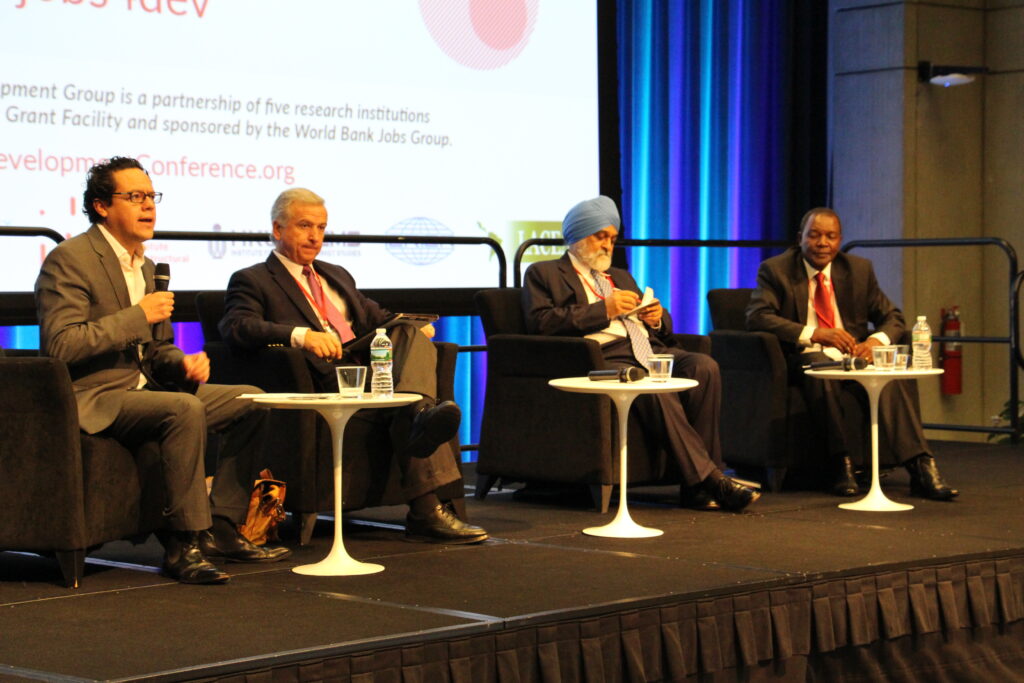
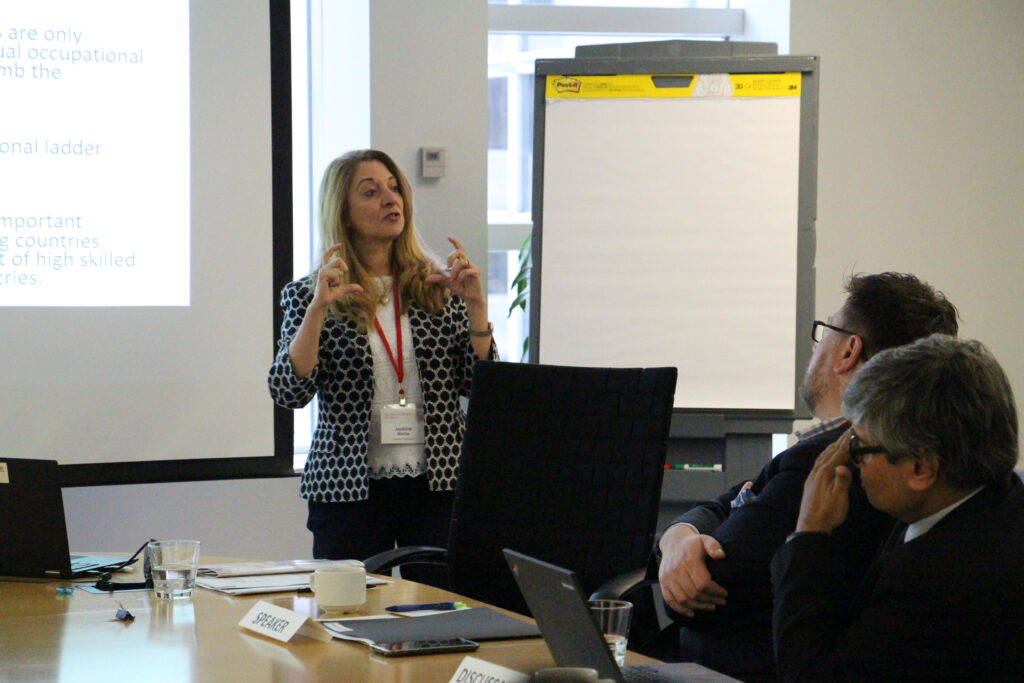

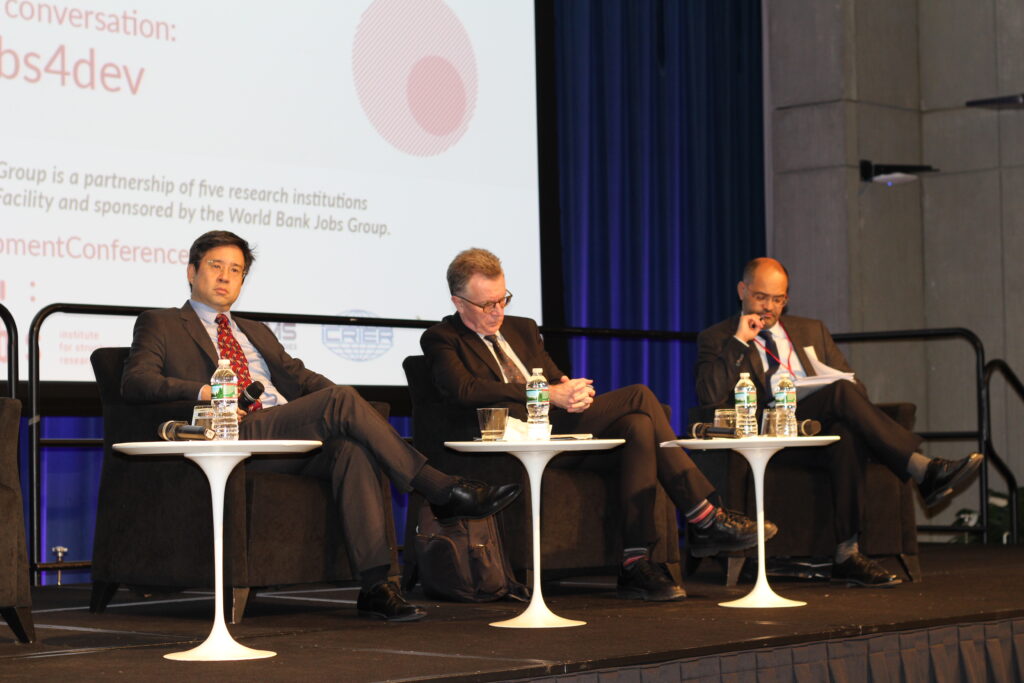
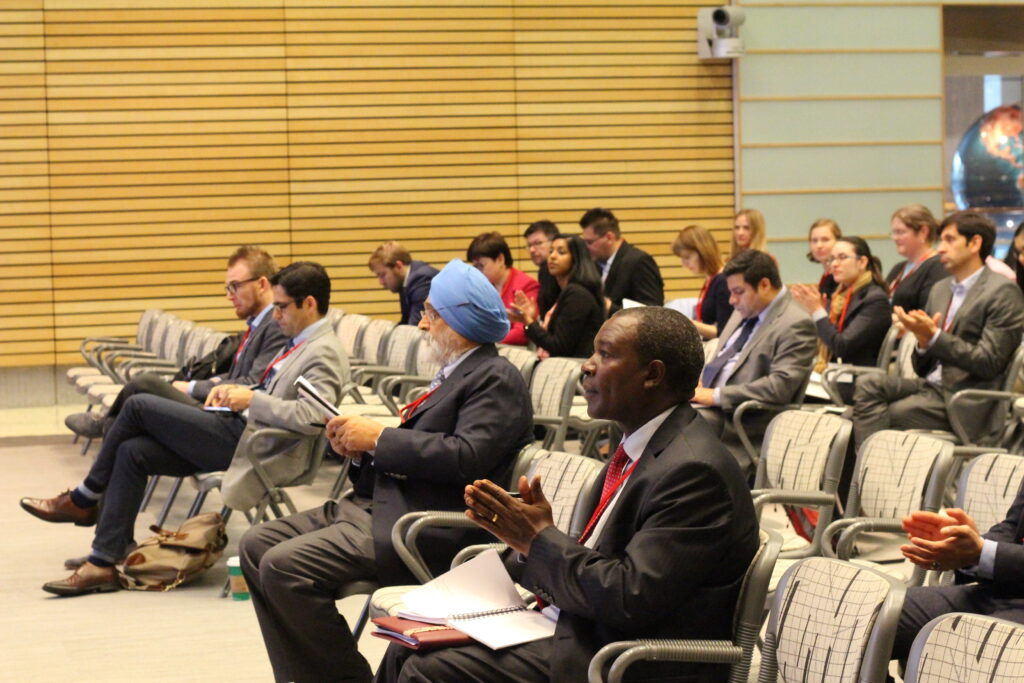
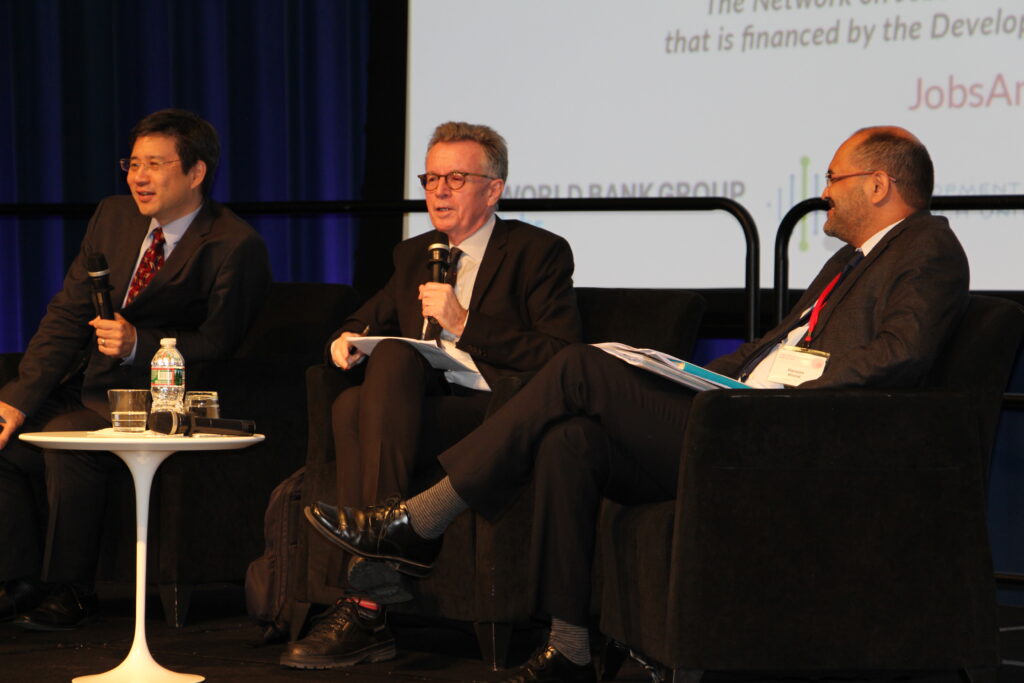
photos: Sarah Marriott, Development Policy Research Unit at University of Cape Town
The Nuances of Labour Regulations
A range of papers were devoted to the complex interplay between labour market regulations and their enforcement, job creation, and job quality. Several speakers focused on the use of contract labour in India. Contract employment accounts for 40% of total employment in the manufacturing sector in India, and the likelihood of becoming a regular worker after being a contract worker is relatively low in this country compared to developed economies. Nancy H. Chau (Cornell University) utilised a rich data set (annual survey of industries in India) to test predictions from a theoretical model and to find that contract employment improves efficiency, that regular workers are paid through efficiency wage, and that contract workers are paid through the value of unemployment (much lower than efficiency wage). She also found that the contract wage elasticity with respect to regular wage is positive but rather low, which should contribute to wage polarization. Deb Kusum Das (ICRIER) and Homagni Choudhury (Aberstwyth University) presented results of a firm survey, and showed that in India, larger firms hire more contract workers than smaller firms. They highlighted that the main reason for hiring contract workers is not a freedom of (non-)compliance, but meeting a temporary demand. Nick Tsivanidis (University of Chicago) discussed the relationship between contract labour and firm growth. He showed that the change in the Indian manufacturing sector driven by the increased supply of contract workers increased manufacturing GDP by 0.56% from 1998 to 2011. Finally, Anwarul Hoda (ICRIER) provided an overview of labour regulations in India since 1947, and compared them with those prevailing in major developed and emerging economies, in order to draw lessons for reform directions.
The Jobs and Development Conference was organised by the World Bank Jobs Group and the Network on Jobs and Development – an international network of research institutes comprised of the Development Policy Research Unit at University of Cape Town (DPRU, South Africa), the Indian Council for Research on International Economic Relations (ICRIER, India), the Institute for Structural Research (IBS, Poland), the Latin American and Caribbean Economic Association (LACEA), and the Hong Kong University of Science and Technology Institute of Emerging Market Studies (HKUST IEMS).
Prabirjit Sarkar (Jadavpur University and University of Cambridge) presented a new database on labour regulations around the world, and using this novel data he argued that in general there is no evidence that more stringent labour regulations reduce employment. Piotr Lewandowski (IBS) elaborated on the temporary employment boom in Poland and its effects on job quality. He showed that in comparison to permanent workers, temporary workers have experienced lower job quality in multiple dimensions. At the same time, the related potential employment gains in Poland were rather modest. A special session of the Network for Jobs and Development was devoted to compliance with labour regulations. There is a substantial variation in enforcement of the letter of law in various countries, and sometimes even within countries, but the issue is often overlooked and it is often assumed that de jure regulation corresponds to the de facto one. Lucas Ronconi (CIAS and CONICET) pointed out this apparent paradox of the negative correlation between higher regulation and lower enforcement across countries. He discussed potential rationales behind this relationship: none of the standard explanations (low financial resources for enforcement, different preferences or ideology, political power/cronyism or different legal origins across countries) provide a satisfactory explanation so far. Yang Du (CASS) presented the results of the 2008 reform in China which strengthened labour market regulation. Enforcement was stronger in cities where it was previously lower, and this was accompanied by slower employment growth. He also found that employment in exporting firms exposed to adverse export demand shocks was less sensitive to enforcement of labour regulations. Even if non-compliance to labour market regulation is particularly strong in developing economies, Piotr Lewandowski (IBS) showed that non-compliance with statutory minimum wages in Central and Eastern European countries is non negligible. Non-compliance is prevalent among vulnerable groups of workers, notably women and temporary workers, and it is tightly linked to the level of minimum wage. Giulia Lotti (CAGE Warwick) also found that higher minimum wages are associated with higher non-compliance in a sample of 59 low and middle income countries. She also showed that a higher minimum wage is associated with a larger self-employment share. Jorge Eduardo Pérez Pérez (Brown University) analysed an unexpected increase in the real minimum wage during the 1999 Colombian economic crisis, and found that it reduced employment in the informal sector, but not in the formal sector, which experienced noticeable wage increases. On the other hand, Cecilia Poggi (University of Sussex) analysed a minimum wage policy shift implemented in Thailand during the economic boom, to find that employment was weakly affected while wages rose up to the 60th percentile, which suggests that the minimum wage was used as a reference point for wage-setting across the economy. This was one of many papers showing that a country-specific labour market context and practice matters a lot for policy making. Attention was also paid to collective bargaining and trade unions. Hector Gutierrez Rufrancos (University of Sussex) analysed the Mexican experience, and demonstrated that strike threats are responsive to business and political cycles – they increase with rising unemployment and during election years. Moreover, he showed that unions strategically manipulate strike threats to increase voter turnouts, particularly in narrow-win municipalities. Iga Magda (IBS) showed that although union coverage has been decreasing in Central and Eastern European countries, the union wage premium from firm- and industry-agreements increased. She argued that it was the EU accession and adoption of rules giving unions more voice, that made the surviving unions more effective in bargaining. Several papers focused on a related issue of informality. Kunal Sen (ICRIER) showed that most non-agriculture employment in South Asia is in small, informal firms which lack access to credit and barely grow. Prodyumna Goutam (Pardee RAND Graduate School) studied Bangladesh and found that export-led sectoral growth causes a reallocation from formal and informal employment towards self-employment. Tom Gindling (University of Maryland) presented a heterogeneous picture of earnings penalties and premiums for self-employment and informal employees in 73 countries. Informality is often related to the (lack of) social security coverage. Mariano Bosch (IDB) explored pension systems in the Latin America and Caribbean region and found that they struggle with low coverage, inadequate fiscal sustainability, and high costs. He indicated the need for substantial reforms, including financing social security with sources other than labour taxation.
Technology, Jobs and Structural Change
A lot of attention was paid to technological change and its interplay with the labour market. Roma Keister (IBS) discussed the intergenerational divide in the task composition of jobs in Europe. She showed that young workers witnessed the most dynamic task content changes in 1998-2014. Routine-intensive occupations were ageing relatively faster, and the risk of unemployment was higher for people who in the past held a routine-intensive job. Pankaj Vashisht (ICRIER) indicated that non-routine cognitive tasks grew in India, while manual tasks declined sharply. He also found evidence for a rise of routine cognitive tasks in India. Ana Maria Oviedo (World Bank) presented a novel approach to measure the skill content of jobs in low- and middle-income countries using the STEP data. She showed that the importance of tasks intensive in analytical and interpersonal skills increases with a country’s income level, and that the occupation-level distribution of skill content is correlated across countries. Francisco Lima (FGV/EPGE) analysed how environmental regulations in the sugarcane industry in Brazil led to structural transformation and skilled migration. He argued that environmental regulations in developing countries can pay the double dividend of improving the environment and fostering the adoption of new technology, thus driving up wages and structural transition to service sectors. Mariana Viollaz (CEDLAS) used an employer-worker survey in Chile and argued that the adoption of advanced computer software increases the share of skilled workers within company, decreases the share of unskilled ones, and reduces overall employment. She didn’t find such effects for computer use per se. Safia Khan (DPRU and Research ICT Africa) scrutinised the relationships between ICT adoption and employment outcomes in Sub-Sahara Africa, suggesting a positive correlation between mobile ownership and the probability of employment. Xiaobo Zhang (Peking University and IFPRI) focused on e-commerce and entrepreneurship in Taobao village Baigou, China. He argued that e-commerce platforms reduce reliance of trade on personal relationships, provide a secure payment system, and lower the capital requirement for start-ups, which leads to higher entrepreneurship and job creation. In another study of India, Rajat Kathuria (ICRIER) presented the status of ICT penetration and the business process outsourcing impact on industry in rural regions.
Issues related to technology and occupational change were also prominent in research focused on structural transformations. Xianjia Ye (University of Groningen) looked at global value chains, and argued that in developing countries transformation is crucially about “horizontal upgrading” – shifting between various industries but remaining at the same skill and task level in the value chains. Hong Cheng (Wuhan University) used a unique matched employer-employee survey conducted in Guangdong, China (the first employer-employee manufacturing survey ever done in Asia) to analyse how firms respond to structural increase of wages. Crucially, he found a significant negative response of unskilled employment to rising wages. Francois Steenkamp (Development Policy Research Unit, UCT) looked at Africa’s “Manufacturing Malaise”, where economic growth and structural transformation have been driven by services, not manufacturing. He stressed that countries that produce more complex products have a more complex production structure, and higher levels of economic complexity are related to a more diversified export portfolio. Yet on average, the export portfolios of African economies are dominated by primary products, and their productive structure is distant from the productive capabilities required to shift production toward more complex manufacturing activities. Ellen McCullough (University of Georgia) discussed the relationship between occupational choice and labour productivity in Sub-Saharan Africa. By simulating positive labour productivity shocks for occupational choices (farming, wage employment, self-employment – or a combination) she found a multitude of impacts on labour supply, implying large welfare gains from farm productivity enhancement even without changes in occupational choices. This is important considering that in remote areas, farm productivity growth appears to be the only hope for poor households. Luc Christiaensen (World Bank) showed that complete exits from agriculture contribute more to the reduction in engagement of youth in agriculture in Africa than gradual exits (i.e. less hours worked). Aly Mbaye (University Cheikh Anta Diop of Dakar) and Nancy Benjamin (World Bank) argued that productivity is the crux of structural transformation and informality in Francophone Africa. The special World Bank session Making Transformation Work for Africa was prompted by a regional study into why poverty reduction has been slow in Africa despite relatively robust growth. Pierella Paci (World Bank) discussed whether structural transformation is the weak link between growth and poverty reduction on the continent.

While agricultural productivity and reallocation reduce poverty in the developing world, neither does so in SSA. Neither do shifts into manufacturing in Africa look to be poverty reducing. She suggested that future research should be looking at differences across African countries exploiting micro-data. Marco Ranzani (GPV01) spoke about public sector employment expansion which fosters structural transformation away from agriculture, induced by indirect effect demand on non-tradeables. However, he showed that the expansion also hampers structural transformation by increasing unemployment among the skilled, inducing a shift out of agriculture without absorption into the labour market. Mario Macis (Johns Hopkins University) looked at employment diversification and poverty reduction, finding that being diversified in services helps more than being in manufacturing does. He also found that income and consumption are higher among economically diversified households, while households that are fully specialised in industry or services (i.e. no household member employed in agriculture), are less likely to be poor. Vijaya Ramachandran (Center for Global Development), Markus Goldstein (World Bank) and Miriam Bruhn (World Bank), also stressed the role of informality, productivity and firm growth in a session that covered Sub-Saharan Africa, South Asia and Latin America.
Employment Oriented Interventions
Interventions aimed at increasing employment, wages or quality of jobs were important topic of the conference. Yanan Li (Cornell University) used evidence from the NREG employment scheme in India in order to evaluate whether providing public works increases wage bargaining power in the private sector. She found that when husbands work in NREGS, men’s wages rise in the main agricultural season, but when wives work in NREGS, women’s agriculture wages increased in the agricultural off-season. Bruno Crépon (CREST) focused on the impact and post-program effects of public works and training on the youth in Côte d’Ivoire. There were significant impacts on wellbeing during and post-program, and an average 11% increase in earnings. Yet program costs were far larger than the impacts on earnings. Jose Romero’s (World Bank) systematic study explored whether youth employment programs (training and skills, entrepreneurship and promotion; employment services; and subsidised employment) improve labour market outcomes. He found that no consistent type of program showed across-board positive or negative significant effects. There was also no significant effect of soft skills. However, programs addressed to vulnerable workers have had above-average outcomes. Laura Ralston (World Bank) used evidence from labour market and entrepreneurship programs to reveal that there are limited but promising results from public works programs. She argued that there are high returns to capital in self-employment, while higher wages and employment reduce materially motivated crime and violence, but returns to technical skills alone appear low. She warned that policymakers who advocate skills training programs should bear the burden of proof that these programs will work, and that scaling up training programs in new contexts without first demonstrating their cost-effectiveness and their efficiency against alternatives like cash/grants, should be avoided.
Scientific committee Committee chair :Albert Park, Institute for Emerging Market Studies at Hong Kong University of Science and Technology, Hong Kong Committee members: Haroon Bhorat, Development Policy Research Unit at University of Cape Town, South Africa, Deb Kusum Das, Indian Council for Research on International Economic Relations, Delhi, India, Mary Hallward-Driemeier, Principle Sr. Specialist, Trade and Competitiveness Practice, World Bank, Piotr Lewandowski, Institute for Structural Research (IBS), Warsaw, Poland, David Robalino, Jobs Group, World Bank, Sergio Urzua, University of Maryland, NBER, IZA and Clapes-UC
Job creation is especially challenging in the context of conflict and fragility. The papers devoted to these challenges took various angles, from a deep dive and stock take summary on what we know of employment programs working in such contexts, to the case study of the challenges of creating jobs in Kashmir, India. Ali Mehdi (ICRIER) spoke on Kashmir in the terms of job creation challenges revolving around material, human and freedom (political, economic and social) development. He stressed that in the intermediate term, competitiveness of traditional sectors relies on skills development, access to credit/investment, access to national/international markets, and promoting industry by enhancing security. In the medium term it will rely on infrastructure development, and the long term the focus must be on the development of human capital. Emily Weedon Chapman (World Bank) presented the outcomes of a novel qualitative toolkit piloted in Liberia. She explained the importance of filling the knowledge gaps in the design of effective policies that would improve the productivity of non-agricultural household enterprises (HEs). HEs are one of the main sources of employment in fragile and conflict contexts, where the challenge is often rather more about underemployment than unemployment. Her findings revealed HEs are preferable to, and more profitable than, salaried work, because of weak business environments, lack of access to and poor financial and human resources, challenges of education and skills, and the youth’s attitudes toward work. Andrés Moya (University of Los Andes) linked the impact of violence and psychological trauma on socioemotional skills among beneficiaries of a labour training program for young victims of violence in Colombia. He stressed the need for better diagnostics of vulnerability and characteristics of targeted populations. The design of labour training programs (the most frequent intervention to promote employment) must be adjusted to tackle specific characteristics and challenges amongst adolescents exposed to violence or in contexts of extreme adversity. Pablo Egana del Sol (Columbia University) looked at late stage investment on at-risk youth and found that social programs don’t seem to affect socio-emotional skills. Guillermo Cruces (CEDLAS-UNLP) analysed long-term experimental evidence on youth training impact on soft skills, hard skills and labour market outcomes in the Dominican Republic. He found no long-run effects on labour market outcomes, but strong lasting effects on personal skills acquisition and expectations – these effects were more positive for women. Gabriel Ulyssea (Pontifical Catholic University of Rio de Janeiro) studied a two-year large scale program aimed at reducing costs of entering the formal sector in Brazil, to find that lowering taxation had a sizeable impact on formalisation of micro-firms, while reducing registration costs alone was not enough to increase formalisation. In another paper on Brazil, Stephen O’Connell (MIT) evaluated a demand-based vocational training program (Pronatec-MDIC). He found that the vocational training increased the probability of employment (but not wages) within the six months of course completion. Tomás Rau (Pontificia Universidad Católica de Chile) study of the take-up of the employment subsidy for vulnerable youths in Chile showed the importance of the peer effect at the co-workers level. María Prada (IDB) distinguished between various types of skills and found, among others, positive wage effects of high mechanical ability, especially among individuals who didn’t attend college, suggesting that an advanced degree is not the only path to better incomes. One of the reasons why outcomes of interventions or schooling are sometimes less positive than policy-makers hope, is related to a mismatch between labour demand and supply. Agnieszka Chłoń-Domińczak (Warsaw School of Economics) proposed a qualifications-based framework for measuring skills mismatch, and applied it to European countries to find that overskilling is more likely in retail and sales, hotels and restaurants, but also in the information and communication sector. Interventions in other areas of public policy can also have labour market consequences. Nathalie Picarelli (London School of Economics) analysed a subsidised housing program in South Africa. She found that subsidised housing programs without considering spatial aspects (location, distance from economic centres, transport infrastructure) can have unintended consequences – in South Africa, construction areas were located far from economic centres therefore making commuting costs higher for dwellers, which in turn was related to declining labour supply, especially among females.
Opportunity, Equality and Work
Job opportunities influence humans’ decisions to invest in skills, reallocate or participate in markets, but opportunities also arise from these decisions, often leading to unequal outcomes. Paweł Kaczmarczyk (University of Warsaw) drew lessons from a recent Central and Eastern European (CEE) experience of emigration wave that followed the introduction of freedom of movement. He argued that in CEE, migration has been a step in an occupational / life-cycle plan, rather than a survival strategy. He also argued that CEE emigration was not a brain drain, but rather a brain gain, as the freedom of movement increased the potential returns to education. Jackline Wahba (University of Southampton) provided another example of brain gain effects in her study of return migration to Egypt. She found that return migrants had a higher probability of upward occupational mobility than their similar peers who stayed. Ragui Assaad (University of Minnesota’s Humphrey School of Public Affairs) analysed transitions from school to work in three MENA countries (Jordan, Egypt and Tunisia). He found that the very rapid increase in education attainment in this region was primarily driven by the aspiration of finding a “good” job and a desire to work in self-employment outside of family businesses. However, access to good jobs for educated workers has become increasingly tied to social class, which in turn increased frustration of youth. Karmen Naidoo (University of Massachusetts) discussed income inequality in Africa. She traced some back to economies’ dependence on resources and related weak governance, but she also stressed that economic growth is not sufficient for poverty and inequality reduction, since it is rarely pro-poor in countries with high inequality, especially in Africa. Michał Brzeziński (University of Warsaw) looked at factors behind changes in inequality of opportunity in seven Central and Eastern European countries. He found that absolute changes in inequality were mainly related to changes in parental education, while relative changes were driven by full time employment rates, in particular, the decline in inequality was driven by rising employment and wages. Labour income was also the most important factor behind the recent reduction of income inequality in Latin America, as was shown by Carlos Rodriguez-Castelan (World Bank). This was related to a decline of an experience premium of older workers, and a sharp decline of the urban/rural earnings gap. However, the gender pay gap in Latin America barely changed during the 2000s. Several papers looked at the gender dimension of jobs and development. Achyuta Adhvaryu (University of Michigan) has shown that teaching soft skills in the workplace can be profitable for firms, as evidenced by the results of an experiment carried out with female garment workers in India. Manoel Bittencourt (University of Pretoria) studied the negative impact of secondary school enrolment on fertility in the Southern African Development Community. Arti Grover Goswami (World Bank) showed that despite competition-inducing reforms in India, the patterns of female activity and gender segmentation did not change much. Teresa Molina (University of Southern California) studied the gender-specific responses to early-life health shocks, showing why exposure to pollution in the second trimester of gestation lead to significantly lower cognitive ability in adulthood for both men and women, but also to lower high school completion for women only. A special session presented the findings of the Counting Women’s Work project, which aims at acknowledging women’s full economic contribution by accounting for the value of unpaid household production. The presentations by Gretchen Donehower (University of California, Berkeley), Pamela Jiménez-Fontana (Centro Centroamericano de Población and Programa Estado de la Nación de Costa Rica) and Morné Oosthuizen (Development Policy Research Unit, UCT)) combined the framework of National Transfer Accounts with that of National Time Transfer Accounts, and show how much time men and women spend in unpaid household production, what that time is worth in market terms, and who consumes it. The disaggregation by gender and across age helped to better capture paid and unpaid inputs, in order to understand how population change impacts economic growth, investments in human capital, family and public support systems for children and the elderly, and what is the gender role in these processes. The interaction between household duties and market work was also scrutinised by John Giles (World Bank), who analysed elderly care and labour market outcomes using data from the China Health and Retirement Longitudinal Study (CHARLS). He found that having a caregiver for a disabled elderly parent in the household has a modest but significant effect on labour supply.
What comes next
The first joint conference of the Network on Jobs and Development and World Bank Jobs brought together researchers and policy influencers from all around the world, who discussed a broad range of issues beyond the traditional labour economics domain. The conference highlighted the importance of analysing interactions between labour and factors such as technology progress, urbanisation, regional development, sectoral policies, and interventions at various stages of the life-cycle, from early-life till retirement.
The second conference is planned for Autumn 2017
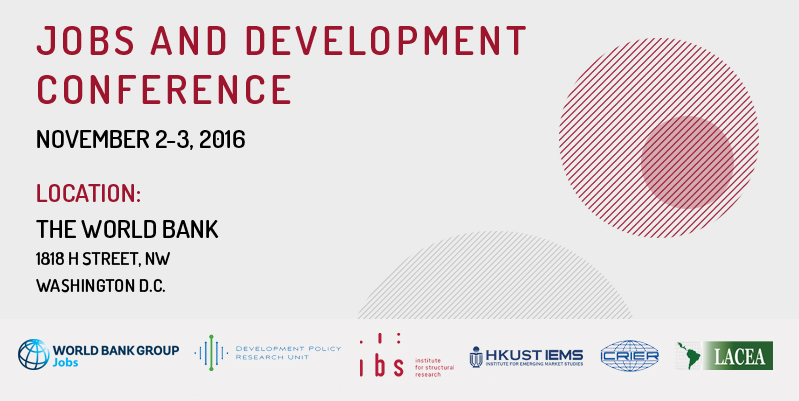
 Jobs_and_Development_2016_Conference_Brochure-1.pdf
Jobs_and_Development_2016_Conference_Brochure-1.pdf
 Lewandowski-Minimum-wage-violation-in-CEE_Jobs4Dev-1.pdf
Lewandowski-Minimum-wage-violation-in-CEE_Jobs4Dev-1.pdf
 Lewandowski-Job-quality-quantity-trade-off-Jobs4Dev-1.pdf
Lewandowski-Job-quality-quantity-trade-off-Jobs4Dev-1.pdf
 Magda-Coll-barg-and-wages-Jobs4Dev-1.pdf
Magda-Coll-barg-and-wages-Jobs4Dev-1.pdf
 Keister-Intergenerational-divide-in-tasks-Jobs4Dev-1.pdf
Keister-Intergenerational-divide-in-tasks-Jobs4Dev-1.pdf


